Simmered Kingfish with Daikon (white radish) is considered a winter dish because winter is the best time for both kingfish and daikon. Cooked in a soy-based broth, the amber-coloured daikon and kingfish are so juicy and tasty.
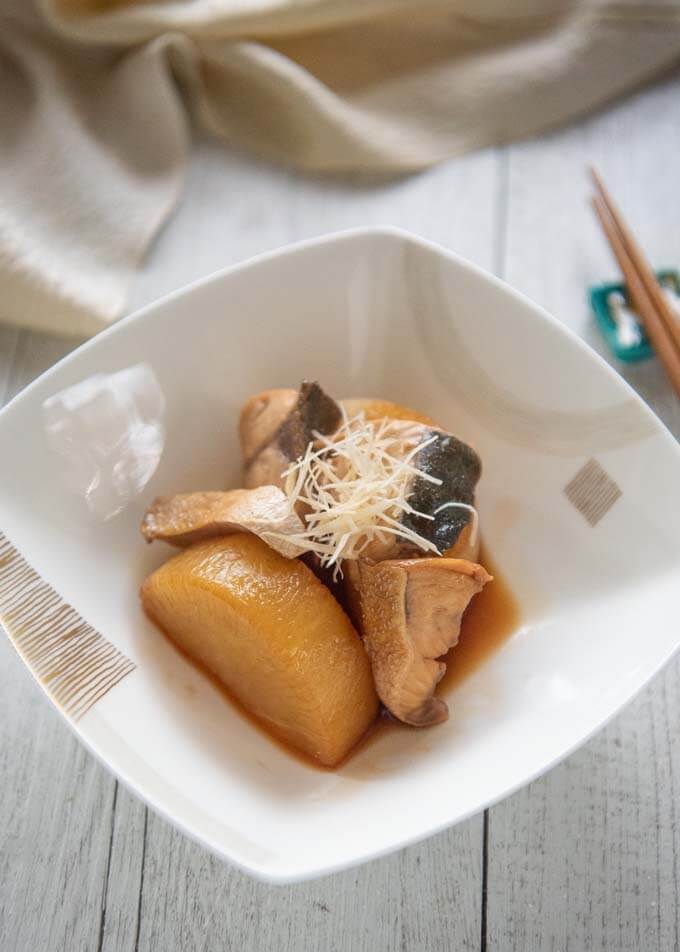
The flesh of the kingfish contains more fat in winter, which makes Simmered Kingfish with Daikon rich and tasty when made in winter. You can of course make it any time throughout the year since daikon and kingfish are available all year round these days.
Simmered Kingfish with Daikon is called ‘buri daikon’ (ブリ大根), which means kingfish (ブリ) & daikon (大根). Good Buri Daikon has to tick all of the following:
- Daikon pieces are semitransparent and amber colour.
- The flavour is soaked into the centre of the daikon pieces.
- Kingfish pieces are not dry.
- The broth is not fishy.
- The broth is not cloudy with fish bits.
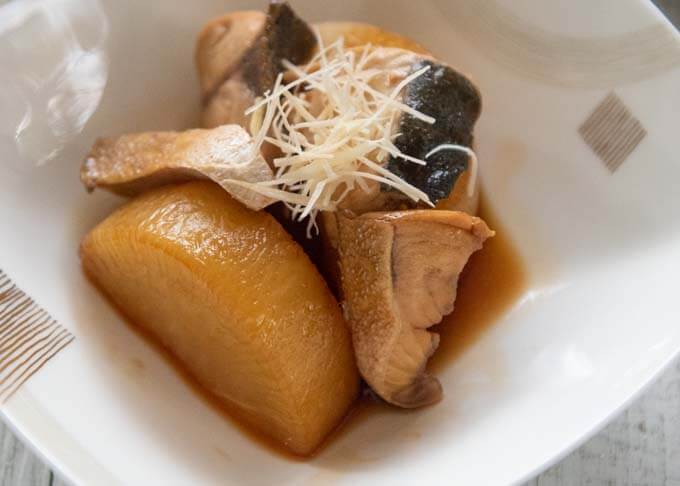
The key to making a delicious Buri Daikon is the preparation of the daikon and kingfish fillets before simmering them in a sauce.
Three Kingfish Species, and many names
When it comes to the name of fish in English, I often get very confused. This is because:
- In different parts of English-speaking countries, the same species are called different names.
- The name of the fish is sometimes used loosely to and refers to different species. E.g., kingfish can be yellowtail amberjack, yellowtail kingfish, hiramasa, or great amberjack.
Japan is famous for seafood and its food culture is developed around it. Because of this, even a slightly different species of fish is called a different name, and some species have even gained different names at different stages of their growth.
In the case of the kingfish family, there are ‘buri’ (ブリ), ‘hiramasa’ (ヒラマサ), and ‘kanpachi’ (カンパチ). They are all different fish. Buri however is the name of the adult species and the younger fish of the same species are given different names depending on the size.
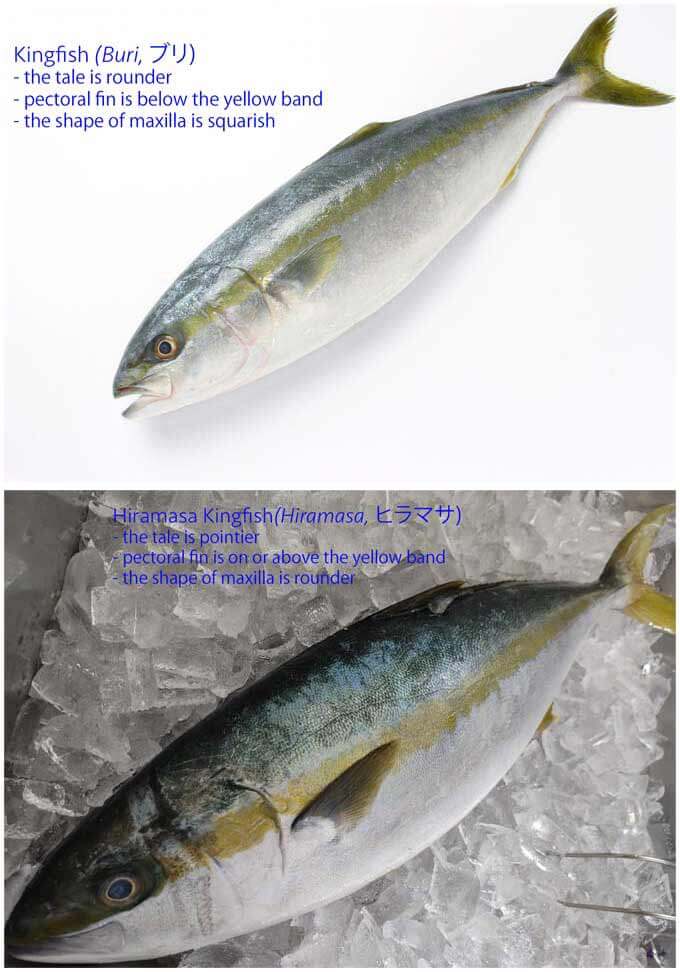
When buri is very young (about 20cm/0.7ft long), it is called ‘wakashi’ (ワカシ). The 40cm/1.3ft long fish of the same species is called ‘inada’ (イナダ) or ‘hamachi’ (ハマチ), and the 60cm/2ft fish is called ‘warasa’ (ワラサ). Only if the fish becomes 80cm/2.6ft or larger, is it given the name ‘buiri’ (ブリ).
This kind of fish, which changes the name as it grows, is called ‘shusseuo’ (出世魚). The word ‘shusse’ (出世) means promotion, and ‘uo’ (魚) is fish. Shusseuo is given different names because the appearance, the shape, and the flavour of the fish change at different stages.
In Australia, kingfish is often referred to hiramasa kingfish. Compared to buri, the flesh of hiramasa is much lighter and less oily. Traditional Buri Daikon is meant to be made with buri, not hiramasa. But I don’t see buri sold at the Sydney fish market very often. So, I used hiramasa kingfish for Buri Daikon today.
What’s in my Simmered Kingfish with Daikon (Buri Daikon)
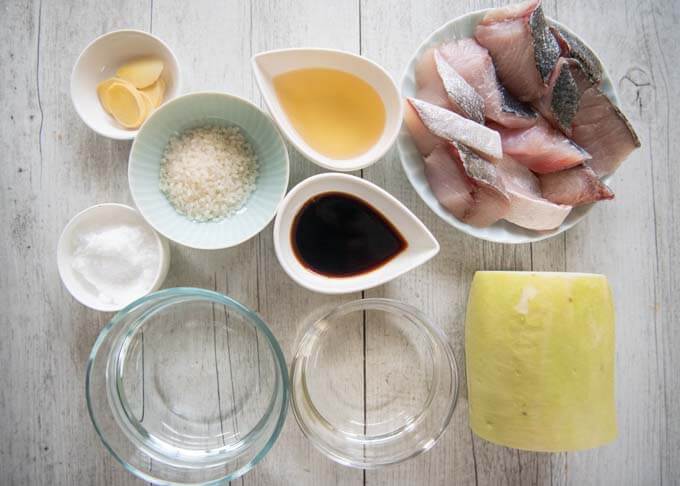
- Daikon cut into 2-2.5cm/¾-1″ thick discs or semicircle discs
- Rice
- Kingfish fillet, cut into large bite-size pieces
- Salt
- Ginger, thinly sliced
Simmering Sauce
- Water
- Cooking sake
- Sugar
- Mirin
- Soy sauce
Topping (optional)
If your daikon is very large in diameter, you need to halve each disc. Otherwise, it will take too long to cook, and it won’t look nice when plated due to unbalanced size of the fish and the daikon.
The ideal thickness of a kingfish fillet is 1.5-2cm/⅝-¾”. I bought a kingfish cutlet and removed the bones before cutting it into smaller pieces.
Haroshōga is optional but it cleanses your palate.
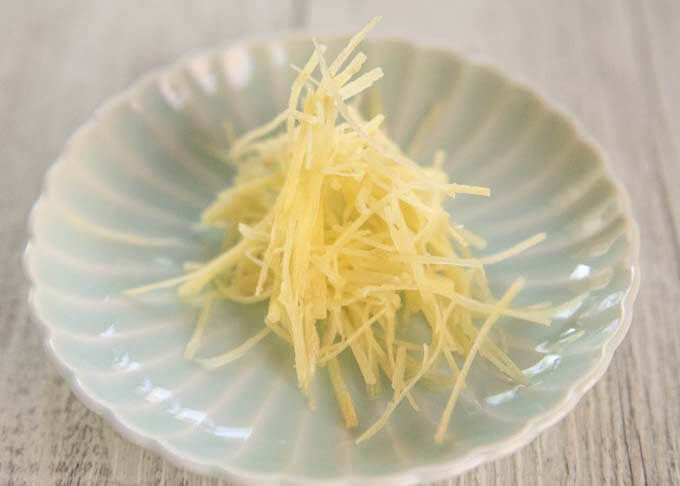
Harishōga needs to be made crisp so that they can almost stand.
How to Make Simmered Kingfish with Daikon (Buri Daikon)
Prior to cooking the daikon and kingfish in the simmering sauce, you need to prepare them in a particular way.
The purpose of daikon preparation is to remove the daikon smell, make the daikon whiter, and pre-cook it until almost tender. As for the kingfish, you want to eliminate the fishy smell from it and remove any scum bits off the fish before simmering.
See the video for the entire process of cooking Buri Daikon.
Preparation
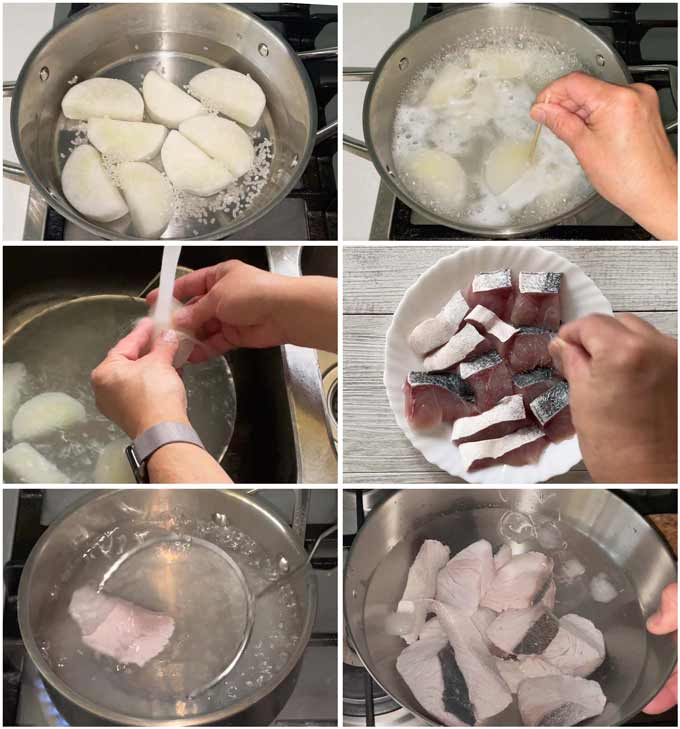
- Pre-cook daikon as per the recipe, Simmered Daikon (up to Step 6).
- Sprinkle salt over the fish pieces and leave for 5 minutes.
- Blanch fish pieces and quickly chill in a bowl of ice water. Remove scum attached to the fish pieces.
Simmering
Throughout the entire simmering process, you need to place a drop lid on.
- Cook daikon in water and sake until the water reduces to 2/3 of the original depth.
- Add sugar and mirin and continue to cook until the liquid reduces to cover half the height of the daikon pieces.
- Place the fish fillets on the daikon pieces, scatter the sliced ginger, and pour soy sauce over.
- Cook with a lid on for 5 minutes or so.
- Remove the lid and cook further to reduce the sauce until a small amount of sauce is left.
- Serve with harishōga on top, if using.
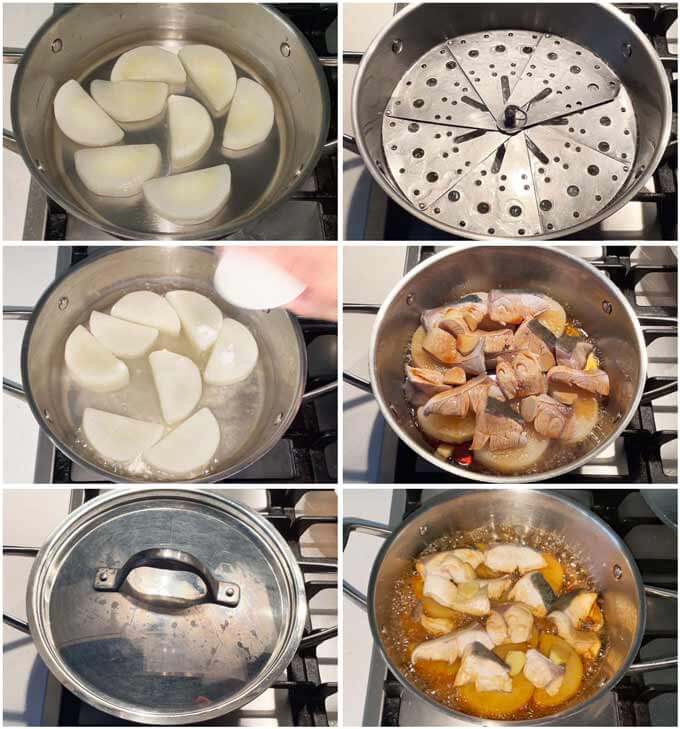
Cooking with a lid on for a short while in step 4 is to bring the bubbles of the sauce above the drop lid level so that the flavour penetrates the fish pieces. If required, use a ladle to take some sauce and pour it over the fish.
Simmered Kingfish with Daikon (Buri Daikon) is a hearty dish. Surprisingly, the dish is not fishy at all despite the amount of kingfish included in this dish. It can be a side dish as well as a main dish.
Buri Daikon keeps for a few days in the fridge. It actually tastes better the next day since the flavour penetrates the daikon and the fish pieces.
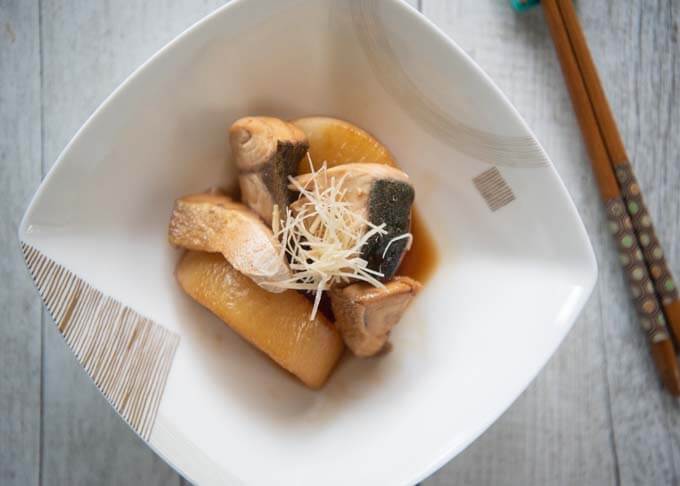
Yumiko![]()
Watch How To Make It
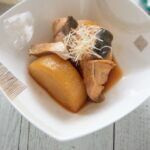
Simmered Kingfish with Daikon is considered to be a winter dish because winter is the best time for both kingfish and daikon. But you can of course make it all year round. Cooked in soy-based broth, the amber-coloured daikon and kingfish are so juicy and tasty. See the video.
Don't forget to see the section 'MEAL IDEAS' below the recipe card! It gives you a list of dishes that I have already posted and this recipe that can make up a complete meal. I hope it is of help to you.
- 500g/1.1lb daikon peeled
- 2 tbsp rice or white liquid from washing rice
- 350g/0.8lb kingfish fillet (note 1)
- ⅔ tsp salt
- 300ml/10.1fl.oz water
- 120ml/4.1fl.oz cooking sake
- 30g/1.1oz sugar
- 50ml/1.7fl.oz mirin
- 40ml/1.4fl.oz soy sauce
- 10g/0.4oz ginger thinly sliced
-
Cut the daikon into 2-2.5cm/¾-1" thick discs. If the daikon discs are very large, halve them.
-
Using a peeler or a knife, trim every edge of the daikon pieces. This is called ‘mentori’ (面取り), which prevents the edges of the vegetable pieces from crumbling while being cooked.
-
Follow the instruction steps 3-6 of my recipe, Simmered Daikon (Daikon Fukumeni) to pre-cook daikon pieces.
-
Cut the kingfish fillet into large bite-size pieces.
-
Sprinkle salt all over the fish pieces and leave for 5 minutes (to remove fishy smell).
-
Bring water (not in the ingredient list) to a boil in a saucepan that is wide enough to fit a flat sieve or a slotted spoon in. Then, reduce the heat to gently boil.
-
Take one piece at a time, place the fillet on the sieve/spoon and lower it into the boiling water.
-
Shake a little bit and as soon as the colour of the fish piece changes to white with no raw patches, transfer the fish to the ice water. Do not overcook the fish.
-
Examine each fillet in the ice water and remove the scum if it is stuck on the fish. You can leave the fish in the ice water until required.
-
Put water and cooking sake in a shallow saucepan that can fit the daikon pieces in without overlapping.
-
Put the daikon pieces in the pan, place a drop lid on, and bring it to a boil. Cook for 15 minutes or so, until the water reduces to about 2/3 of the original depth.
-
Add sugar and mirin to the pot and continue to cook with the drop lid on until the liquid covers half the height of the daikon pieces.
-
Place fish fillets on top of the daikon, scatter the ginger, then pour soy sauce over.
-
Place the drop lid on and cook for 5 minutes with a lid on (note 2).
-
Remove the lids and continue to cook until the sauce reduces to a small amount (note 3).
-
Transfer daikon and kingfish pieces to a serving dish. Pour the remaining sauce over them.
-
Serve with harishōga on top if using.
1. I used hiramasa kingfish cutlet today. It was about 2cm/¾” thick. The ideal thickness of the fillet is 1.5-2cm/⅝-¾”. If your fillet is wide, slice it into thin pieces.
If you can buy a large and fatty kingfish fillet, that would be the best.
2. You may shake the pot so that the simmering sauce penetrates the fish pieces.
3. You may want to use a ladle to pour the sauce over the fish so that fish gets more flavour.
4. Buri Daikon keeps in the fridge for a few days. It actually taste better the next day since the flavour penetrates the daikon and fish pieces.
5. Nutrition per serving as a side.
serving: 351g calories: 257kcal fat: 4.8g (7%) saturated fat: 1.2g (6%) trans fat: 0.0g polyunsaturated fat: 1.3g monounsaturated fat: 1.8g cholesterol: 48mg (16%) sodium: 1046mg (44%) potassium: 718mg (21%) carbohydrates: 21g (7%) dietary fibre: 2.1g (8%) sugar: 16g protein: 22g vitamin a: 1.7% vitamin c: 50% calcium: 4.8% iron: 6.4%
Meal Ideas
A typical Japanese meal consists of a main dish, a couple of side dishes, a soup and rice. I try to come up with a combination of dishes with a variety of flavours, colours, textures and make-ahead dishes.
For today’s Meal Idea, I placed Buri Daikon as a main dish but with the quantity of a side dish. To supplement protein, I picked side dishes that contain protein. Side dish 1 can be a vegetable dish. The vinegar-based dish goes well with the simmered fish.
Chawanmushi is one of the best matches for Buri Daikon. The gentle flavour of the savoury custard goes well with the sweet soy flavour of the main dish.
Your soup can be either miso soup or clear soup, but a soup with a lot of vegetables such as Kenchinjiru or Tonjiru makes the meal well balanced.
- Main: Simmered Kingfish with Daikon (Buri Daikon) – today’s recipe, make ahead.
- Side dish 1: Octopus and Cucumber Sunomono (Vinegar Dressing) – or Cucumber and Seaweed Sunomono (Vinegar Dressing).
- Side dish 2: Chawanmushi (Savoury Egg Custard).
- Soup: Japanese Vegetable Soup (Kenchinjiru) – or Tonjiru (Pork and Vegetable Miso Soup).
- Rice: Cooked Rice.
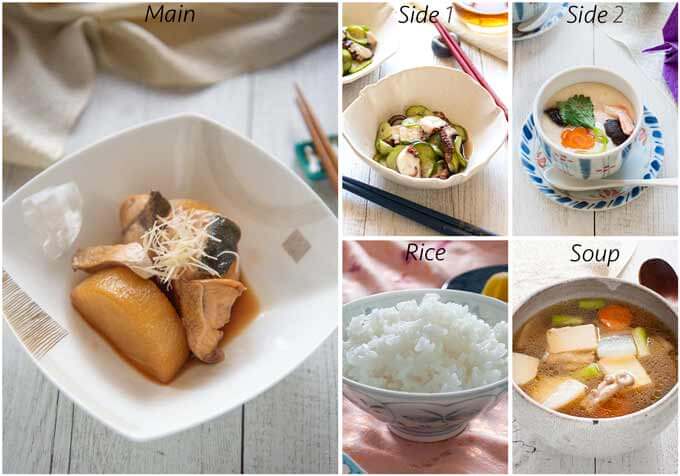
Leave a Reply